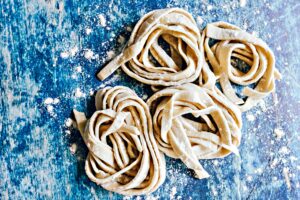
3-Ingredient Homemade Organic Kamut® Noodles
One of the most delicious things to make at home is a great pasta! Today we’re using the ancient wheat variety known as Kamut®.
No-Fail Sprouted Wheat Bread Basics ( Plus Our Chef’s Tips for Using Sprouted Wheat Flour)
“When grains are sprouted they are converted into a raw, living food with more vital nutrients which are more readily absorbed by the body. Sprouted grain companies suggest that sprouted flours are digested by the body as a vegetable not as a starch.
When grains are sprouted, enzymes are created that aid digestion. Complex sugars are also broken down and as a result, painful intestinal gases and potent carcinogens and enzyme inhibitors are neutralized. This is especially beneficial for those people with intolerance to wheat as they often discover that they can digest sprouted grains without any problem (this may not apply to those with celiac disease). Grains are normally digested as starches using pancreatic enzymes but when grains are sprouted the starch molecules are changed into vegetable sugars which the body then digests as a vegetable.
According to research done by the University of Minnesota, sprouting increases the total nutrient density.
These studies also demonstrated a significant increase in various enzymes including amylase, lipase and Protease.
Sprouting grains also helps with the body’s absorption of calcium, magnesium, iron, copper and zinc as reported by the Price-Pottenger Nutrition Foundation.”
*Resources: www.organicwheatproducts.com, www.healthyflour.com/about-us/why-sprouted
We Think You'll Like

One of the most delicious things to make at home is a great pasta! Today we’re using the ancient wheat variety known as Kamut®.

We’re elevating your favorite weekend pancakes with the rich and warming flavors of vanilla, blackberries and cardamom.

This recipe celebrates everything we love about summer treats. It’s creamy, dreamy, sweet and delicious.

One of the most delicious things to make at home is a great pasta! Today we’re using the ancient wheat variety known as Kamut®.

We’re elevating your favorite weekend pancakes with the rich and warming flavors of vanilla, blackberries and cardamom.

This recipe celebrates everything we love about summer treats. It’s creamy, dreamy, sweet and delicious.